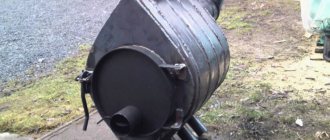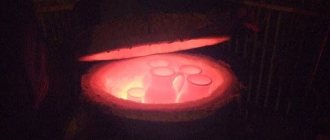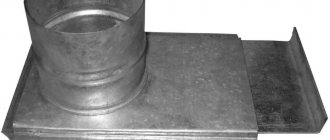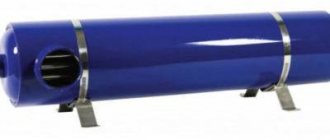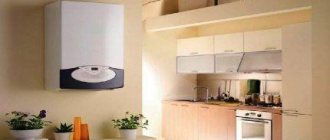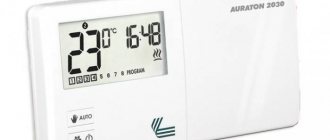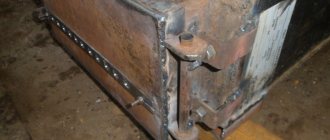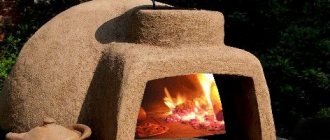An excellent option for organizing an autonomous heating system in a private house or bathhouse is a stationary stove with a water heating boiler.
Such a device is practical and economical, has high heat transfer and efficiency, which allows you to effectively heat rooms of various sizes in a short period of time.
It is quite easy to organize such a system yourself, without involving expensive specialists.
Design features of a furnace with a circuit
A stove with a heating circuit ensures uniform and rapid heating of the room thanks to the coolant (water or other liquid) located inside the system. The thermal energy released during the fire is used to heat the room and heat the water in the system.
Heating equipment of this type is equipped with a metal heating circuit. It is a tank with fittings and pipes connected to them.
Modern stoves with a heating circuit are made of metal or refractory brick, with different placement of the heater, as well as with a water tank.
Structurally, the furnace boiler is presented in two types:
- Boiler in the chimney. This device is characterized by high performance characteristics, long service life and ease of use. The only drawback of the design is the inability to heat large rooms.
- Boiler in the firebox. It is intended for heating large areas, is accessible and durable. The disadvantages include close contact with open fire, which leads to severe overheating and destruction of metal structural elements. In addition, a high temperature of the heating circuit leads to the rapid formation of soot and a decrease in the efficiency of the device.
Disadvantages of a brick chimney
The latest models of gas boiler operate on the principle of economical consumption of resources. The heating gas is turned on when the temperature sensor is triggered, reaching the set temperature, and turns off. The chimney cools down and condensation forms in it. Natural gas contains various microelements in small quantities. When reacting with water, combustion products form solutions of hydrochloric, nitric and sulfuric acids.
An aggressive environment is formed inside the channel, which leads to rapid destruction of the brick and cracking of the seams. Every 5 years the pipe must be repaired. The gas service has many requirements for such chimneys, and inspectors are very demanding at the time the facility is put into operation. Low cost is a significant, but the only advantage of mono-brick chimneys. It is possible to repurpose an existing duct into a chimney for a gas boiler only if special liners made of steel or ceramics are used.
Many builders by “brick chimney” mean combinations of brick with stainless steel, ceramics or asbestos cement. Outwardly, it looks like wells made of stone, and liners made of other materials are not visible. Such systems almost completely eliminate the disadvantages of monolithic stone structures, but are significantly less expensive.
Types of heat exchangers for furnaces
When creating an autonomous heating system, two types of heat exchangers are used: flat and tubular.
Flat type heat exchanger
Stove boilers with a flat configuration heat exchanger are a practical option for country houses, private cottages and baths. They are easy to manufacture, install and maintain.
Such devices are mounted vertically and horizontally and have a high efficiency. The flat design of the boiler is characterized by a large chamber volume, which ensures rapid heating of the water necessary for heating and water procedures.
A significant drawback of the equipment is the reduction in thermal output from the furnace wall structures. The heat exchanger is presented in a U-shape and is mounted around the entire perimeter of the firebox. This leads to a decrease in the heating temperature of the external walls of the furnace and an increase in the time for heating the room. This is only problematic in cases where the heating stove is installed inside residential premises, where the combustion process is carried out constantly.
You can increase the heating rate of a flat boiler in several ways: lengthen the heater and place it above the firebox, or use a metal chimney, first increasing its length.
Tube type heat exchanger
A tubular boiler for a stove differs in the type and size of the structure and installation method. If repairs or replacement are necessary, the heat exchanger can be easily removed from the furnace.
Seamless water pipes are used to make a tubular register for a brick stove, so it is considered the most reliable, safe and durable.
When choosing or manufacturing a heat exchanger, you need to remember that its design and dimensions must fully correspond to the shape of the firebox, which will allow heating the maximum amount of water. A high-quality register provides a large heat exchange area.
MDF wall panels: characteristics, advantages and disadvantages
Fiberboard (Medium Density Fiberdoard), widely used in interior decoration, has the same name on the Russian market: MDF wall panel.
The main purpose of MDF is the decoration of offices, shops, balconies and hallways of residential premises. They make good screens for heating devices and window sills. Panels are classified according to two criteria. The first sign is based on the design of the front side:
- MDF with a pattern applied with polymer film or veneer;
- Relief panels coated with varnish.
The second sign is by geometric configuration:
- Lath strips having a slatted shape;
- Square panels, tile format;
- Large sheet panels.
Main operational characteristics of furnaces
A do-it-yourself stove with a water heating boiler is designed to perform two important functions: heating rooms and heating water. In addition, it can be equipped with a hob and oven, which will allow you to use it for cooking.
Heating equipment has a number of advantages:
- A traditional stove emits up to 7 thousand kcal of thermal energy in 1 hour of operation, which is enough to heat a country house. The heating boiler has a higher efficiency, which makes it possible to heat a large residential building and a bathhouse. At the same time, low fuel consumption leads to significant savings.
- A combined heating system consisting of a furnace and boiler provides maximum performance at minimum costs.
- The main fuel is charcoal, firewood or pellets. Such materials are affordable, convenient to transport and store.
- Furnaces equipped with a water circuit do not require continuous combustion. One addition of fuel material per day is enough to ensure rapid heating of the premises and hot water supply.
- The efficiency of combined devices compared to traditional furnaces reaches 85%.
- Any homeowner can organize an autonomous heating system, combined with a water circuit, by preparing the necessary tools and materials.
Long-burning boilers - add firewood twice a day!
This design will appeal to those who are not often at home or do not want to constantly load fuel. Long-burning units are a type of solid fuel boiler in which the combustion process (smoldering) occurs in the upper part of the fuel layer, respectively, and air is supplied from above. There is a built-in water circuit along the entire diameter of the housing, thanks to which the coolant warms up well no matter at what depth the combustion occurs. Due to the combustion of only the top layer, the boiler can operate for up to 30 hours on one load of wood, and some models that are suitable for any type of fuel can operate on coal for almost a week! Most boilers do not contain any energy-dependent equipment; moreover, they are relatively inexpensive and can be designed independently.
True, such designs also have disadvantages, in particular, it is impossible to add fuel while the boiler is burning. Wet firewood is not suitable for burning; it must be well dried to at least 20% humidity and cut into short pieces. If you heat with coal, then only high-quality coal with a low slag content. Another significant disadvantage is the limited capacity of the units. Most of the most popular models operate within 40 kW.
Let's also mention pellet boilers - this is a type of solid fuel boiler, with the only difference that instead of firewood or coal, fuel pellets from waste from the wood processing industry are used. Most units are equipped with a special hopper, from where fuel enters the combustion chamber automatically.
Safety rules for operating furnaces with a water circuit
To ensure proper operation of the stove and boiler, it is recommended to follow important safety rules, as well as recommendations for caring for the equipment:
- Water heating devices must be operated under human supervision. This applies to adding fuel and regularly cleaning the chamber from soot and ash.
- Safe operation of the stove requires control of the smoke exhaust ducts. Before starting the fire, it is necessary to check the technical condition of the channels and the position of the valves. When starting a fire, the valves must be completely open.
- Such a system is recommended for use in winter, when it is necessary to provide rapid heating of rooms and hot water supply. Using a stove with a water circuit in the summer only for cooking and heating water is irrational. In this case, it is recommended to choose more economical heat sources.
- An open fire leads to excessive heating of the stove structure, which can be the main cause of heat exchanger failure.
- When using a homemade heating system, you can install a pumping unit to inject liquid and devices to control pressure levels.
Kholmov's boiler
This modification of the stove is distinguished by the fact that it is equipped with two chambers - for installing a heat exchanger and separately for burning fuel. These devices feature bottom combustion and a full-height firebox, which became the name for them. The principle of operation depends on the design.
The most popular today are two designs:
- Kholmov pyrolysis boilers (PK);
- normal combustion.
The fuel burns at the bottom of the closed combustion space. The second shaft is smaller in size and is used to burn exhaust gases and cool them in the boiler for heating water.
Non-volatile devices control the temperature with an RT3 thermostat installed at the front of the structure. To ensure complete combustion of the fuel, the air supply to it is regulated by the blower door located on the main door of the ash pit.
Kholmov's boiler. Top and side view
A special restriction valve is installed to ensure minimal air passage. In the upper rear part of the unit there is a pipe for connecting a chimney that provides natural draft.
The boiler is equipped with a shut-off valve and compensators on the outside and inside the body, designed to prevent welds from breaking during emergency overheating.
Construction of a brick oven with a heating boiler
Construction work begins after preparing a standard design and manufacturing a heat exchanger, the dimensions of which are used to lay the brickwork of the furnace.
A furnace with a water circuit can be placed in a place convenient for operation and maintenance.
After the construction of the foundation, the arrangement of the furnace is prepared, taking into account the water circuit - a plan for the location of the ash and fuel chamber, the smoke exhaust and the hob (if present).
To build a furnace with a boiler, heat-resistant bricks without chips, cracks or damage are used.
The construction of the furnace is carried out in stages:
- Preparing a kiln solution from clay, sand and water. You can purchase a ready-made mixture, but experienced craftsmen mix the brickwork mortar with their own hands.
- A layer of waterproofing made of roofing material or film is laid on the foundation.
- The oven mortar is evenly applied to the waterproofing and the initial brick row is laid. Next, according to the diagram, subsequent rows are completed, and a heat exchanger is mounted in the firebox.
- An ash pit and a combustion chamber are being built. The correctness of the masonry is checked by the building level.
- The door to the combustion chamber is fixed, the stove vault and chimney are laid out. Rounded bricks are used to line the internal walls of the firebox and chimney.
- After the masonry is completed, the water circuit is installed. Water pipes connected to a heating radiator are supplied to the heat exchanger. An expansion tank is installed, and the finished system is filled with water or other liquid.
The final stage is the decorative finishing of the stove with plaster or tiles, as well as a test firebox to identify and eliminate design flaws.
You can build an economical stove with a heating circuit yourself. This design is safe, practical and durable, with high efficiency, and is also independent of centralized energy sources.
DIY brick cauldron
A solid fuel boiler is an excellent option for solving the heating problem in private homes. If you wish and have all the necessary knowledge and materials, you can build such a thermogenerator yourself, without any help.
Homemade solid fuel boilers can be assembled from pieces of pipes, sheets of steel or brick. However, when building such a heat exchanger, the most popular option is to use brick and metal, since entirely metal structures are often too heavy and expensive.
In addition, a brick boiler can be used not only as a heating device for a private home, but also as a stove for cooking. In this material we will talk about building a brick solid fuel boiler with your own hands.
DIY construction. Materials
To successfully build a blacksmith, you need to pay special attention to the correct choice of materials - due to the fact that the temperatures in the firebox significantly higher than average , ordinary brick will not be suitable for the device.
It is better to choose the most durable heat-resistant material based on fireclay clay , as well as a special masonry mixture from a hardware store.
It is recommended to make masonry mortar yourself only if you have sufficient experience - slight violations of the proportions in the future will lead to cracking and depressurization of the masonry.
Important! It is not necessary to use highly fire-resistant bricks for the external walls of the furnace - this will only lead to a reduction in the service life of the structure. Without receiving good heating, such bricks and masonry mortar will collapse quite quickly.
The heat exchanger will have to be purchased at a specialized store - most often, especially strong steel of sufficient thickness or cast iron . Various additional elements will be required for purchase - valves, doors, hinges, handles and all fasteners that allow you to connect the heat exchanger to the pipeline.
Tools
When building such a structure, you will need to do work with both brickwork and metal parts. Therefore, you will need an appropriate set of tools:
- measuring instruments;
- container for mixing the solution;
- trowel-trowel;
- furnace hammer-pick;
- rule;
- grinder with cutting discs for metal and stone;
- welding machine.
To protect yourself when performing work, you will need protective equipment - glasses and a mask that covers your face from sparks, dust, and special gloves.
Preparing the site
Proper location of the stove will increase its heat transfer and reduce the risk of a fire hazard . The device is not installed close to walls or partitions - the distance to them must be at least 30 cm , the same distance is left from the ceiling.
All surfaces near the device are covered with non-combustible material . The location of the chimney is also very important, as is the ability to properly insulate when passing through the ceilings. When locating a stove with a water circuit, a convenient connection to the heating system must be taken into account.
When building the device, the first step is to equip the foundation:
- A pit is dug out that exceeds the dimensions of the sides of the future device by 15-20 cm .
- A special cushion of sand and crushed gravel 15 cm .
- Formwork made from wooden boards is installed on the compacted drainage layer , which is filled with concrete mixture .
- The foundation is left until completely hardened.
After the foundation has completely hardened, its surface protrudes 10 cm above the floor level two layers of roofing felt waterproofing is laid on it
Stages of work. Order of construction
The construction of the furnace begins with laying the first row of the base on a dry surface , then the following steps are performed:
- The lower part is being built - the height varies depending on the chosen project.
- The bottom of the combustion chamber is laid out from fireclay bricks. No mortar is placed between the layer and the ceramic base.
- Even before equipping the furnace walls, pipes are installed and connected .
- The firebox and outer walls of the furnace are erected - a gap of at least 15 mm , a gap of 5-10 mm is left between the walls of the firebox and the layer of ceramic brick.
- A second cap created with a mandatory air gap.
- The chimney is laid out and insulated .
Principle of operation
The peculiarity of the operation of horizontal and vertical structures is that when fuel is burned, air is heated, which rises and is discharged through the chimney. At the same time, in the process of transferring heat from heated air, cold water is heated in the heat exchanger.
There is also another type of heat generator, in the form of a mine boiler. This design differs from others in the vertical location of the large loading chamber. At the same time, the fuel burns at the bottom of the shaft, and hot air and smoke exit through the second chamber, where the heat exchanger is located.
What is needed
First, you should decide on the dimensions of the future solid fuel boiler and select the most suitable design. Of course, knowing all the aspects of building brick heat generators, you can design and build everything yourself.
However, in the absence of proper knowledge, it is better to carefully read and choose an option from those presented on the Internet.
It is immediately worth noting the fact that when building a solid fuel boiler from brick with your own hands, you will have to deal with welding work, since the heat exchanger is made of pipes or sheet metal.
If you wish, you can buy a ready-made heat exchanger in a specialized store, then you can do without welding work.
Materials
So, from the materials for building a solid fuel boiler made of brick you will need:
- Cement and reinforcement for the foundation. If a brick foundation is planned, then additional amounts of broken bricks and pebbles will be required.
- Fireclay bricks and mortar for laying a furnace.
- Pipes and sheet metal for heat exchanger.
- Doors and grate.
- Water pump.
- Device for heating water.
You will also need tools such as:
- Welding machine.
- Grinder, gas cutter, electric drill.
- A marker that will be used to mark sheet metal.
- Level, pliers and tape measure.
In addition, do not forget about personal protective equipment in the form of gloves, goggles and a mask to protect yourself while working.
Preparing the heat exchanger
To build a brick boiler with your own hands, you first need to prepare a heat exchanger so that you can take dimensions from it for the combustion chamber. That is, you will have to either buy a ready-made heat exchanger or design it yourself.
For example, if you decide to make a horizontal type heat exchanger from pipes, you will need:
- First, prepare pipe sections of the required size.
- Next, holes are cut out of the rectangular pipe in the corner posts, with the help of which the transverse pipes will be joined. Holes are made with a diameter of 50 mm on a face of 60 mm. In total, each rack has 4 holes. 2 more holes are made in the front wall. One is done from below and is required for the return. The second one from the top is for hot water drainage.
- After this, you need to weld the racks to the transverse pipes at an angle of 90 degrees.
- The underwater and outlet pipes are also welded, and then the ends of the rectangular pipes are welded.
Also, a horizontal heat exchanger can be made of steel and pipes. The principle of performing all the work is similar to the option described above, except that in this case the corner posts, as well as the longitudinal pipes, will be replaced with hollow walls.
A vertical type heat exchanger not only provides the ability to transfer heat to the room, but it can also be used to install a stove with one burner. The location of the chimney will depend on its presence or absence.
Masonry technology
Before you start laying the stove with your own hands, you need to choose a diagram and draw an order plan with your own hands; it is better to use ready-made, proven diagrams. An example of such a stove is the Kuznetsov stove with a heating register built into the smoke duct on one side of the stove.
Kuznetsov stove, video
To lay such a stove with your own hands in a private house, you will need the following materials:
- concrete for the foundation;
- red solid brick;
- refractory fireclay brick;
- masonry mortar or its components: clay, clean dry sand, clean water;
- metal pipes for making a heat exchanger.
You also need to buy ready-made elements: grate, doors, dampers, dampers, roof penetrations. The price for these elements is usually quite high, so you need to calculate in advance what exactly is needed.
Required tool:
- trowels and trowels;
- rubber hammer;
- grinder with a circle for bricks;
- levels, plumb lines, twine;
- roulette.
Do-it-yourself sequence of operations
- Mark the position of the future furnace and pour a rod-reinforced foundation 5 cm below the finished floor level. It should not come into contact with the foundation of a private house.
- After the foundation has completely dried, two rows of masonry made of red solid bricks are laid out according to the order scheme and drawing on ordinary cement masonry mortar; their purpose is to level out possible unevenness in the foundation and lay the foundation of the furnace.
- The next rows are laid on clay masonry mortar according to the chosen pattern, observing the dressing indicated on it. The solution is made from pre-soaked red clay, quarry sand and clean cold water. The optimal ratio of clay and sand is determined experimentally.
Properly prepared masonry mortar should not be too plastic or crumbly. You can check it this way: roll a ball the size of a tennis ball out of the solution and drop it from a height of 1 m onto a flat surface. It should be slightly deformed, covered with small cracks, but not crumble.
- The thickness of the joints between the rows of bricks is no more than 5 mm. The smaller the seams, the more uniform the structure of the stove and the better the heat transfer. The jointing is carried out immediately as the laying proceeds.
- The doors are installed like this: an asbestos sheet in the form of a strip is placed on the previous row of bricks at the location where the door is installed, and the door is placed on it. Annealed wire, each at least 40 cm long, is pre-inserted into the holes in the corners of the frame. This wire is fixed between the rows of masonry. If this is not done, sooner or later the solution will crumble and the door will fall out. They lay several rows, all the time checking the position of the door according to the level. An asbestos strip is also laid over the door and brick is laid on top.
- The firebox is lined with fireclay bricks. Red ceramic is not suitable for these purposes - it will crack over time, and the vault may collapse. In diagrams, fireclay bricks are usually indicated in yellow.
- Under the hob, grooves are made in the brick to the thickness of the slab. This is done to reduce heat loss and prevent smoke. The plate is placed on the solution.
- A homemade heat exchanger is installed in the smoke channel during the masonry process at the stage of laying the row through which the lower fitting exits. It is installed in the combustion chamber when laying the bottom row of the firebox. There must be a gap of at least 5-7 mm between the heat exchanger and the brick.
- It is imperative to provide cleaning doors in the smoke channel with the heat exchanger, since soot will settle on the register, which will worsen its heating. The number of doors must provide access for cleaning to any part of the heat exchanger.
- The upper part of the smoke channel is equipped with a damper or damper. The chimney itself can be either brick, or you can buy and install a sandwich chimney. In this case, you need to follow the rules for passing pipes through the roof, and make fluff on brick pipes.
The distance from heated metal elements to combustible structures must be at least 25 cm! Passages through the ceilings are insulated with basalt fiber or other non-combustible materials!
- After the oven has dried, it is carefully heated, without overheating, several times. Check the draft, stability of firewood combustion, and absence of smoke leaks. After this, you can install an external heating circuit and fill the system with water. The oven is ready for use.
How the system works
The simplest water circuit is with natural circulation of water flow. Its basis is a simple physical phenomenon: the expansion of liquids when they are heated. The unit that creates pressure is an expansion tank (a container for collecting water), installed in the attic or attic.
The water circuit is a closed system. The boiler heats the water in it and, expanding, it is directed through a pipe into a storage tank. The movement is carried out under pressure created by the cooled water constantly entering the boiler and passing through the entire system. Boiling water from the expansion tank is directed by gravity down through the pipes leading to the batteries. Having given off the heat, it returns to the tank and heats up again.
Installing a pump will help to significantly increase the pressure in the system and speed up the circulation of the coolant. At average outdoor temperatures, it can be turned off and the circuit will function on the natural movement of water. This will save you on your energy bills. Water enters the pump with the check valve closed. By turning it off (leaving it open), the entire volume of coolant is directed to bypass the pump.
Such a stove can be loaded not only with wood or coal. When using alternative fuels, it is possible to complicate the structure of the system by adding:
- granule storage tank;
- a mechanism that feeds pallets into the firebox (pneumatic or auger).
You can make the operation of the stove easier by installing an automatic system for regulating its operation and forced ventilation.
Installing a water circuit in the chimney
The water circuit heat exchanger has a complex design. One of the options for its placement is to be built into the chimney. The furnace can be initially built with a coil, or it can be built into a ready-made structure.
Peculiarities
This method allows you to use heat, which quickly and practically uselessly flies into the pipe. Wherein:
- The decision to install this type of circuit is made at the furnace design stage. It is virtually impossible to integrate a heat exchanger into the chimney of a stove that has already been put into operation.
- Heat is not taken away from the stove; the firebox heats up to the maximum.
- The degree of heating of the coolant is regulated by the length of the coil. For a large house - a large coil.
- The service life of the coil built into the smoke duct is much longer, since there is no contact with fire.
- Requires a stove with a rather large and complex chimney, which leads to an increase in the size of the stove.
Installing a heat exchanger in the firebox
Boilers installed in the firebox have a variety of designs and do not require a large firebox volume. The spider model heat exchanger shown in the photo has a symmetrical two-sided structure and can consist of a different number of fins. It is quite compact. Through its openings, an open fire perfectly heats the walls of the oven.
Peculiarities
- possibility of heating large areas;
- several options for the structure of the boiler (in the form of a wide tank or flat container);
- flat boilers and tanks have a larger volume than pipe structures and allow some of the water to be used for sanitary needs;
- difficult, but nevertheless a real possibility of embedding into an already folded stove.
A tubular heat exchanger is the most popular solution for installation in a firebox. He can :
- have various simple and complex shapes and dimensions;
- installed on the outside of the firebox or on two or three sides;
- easy to remove from the oven for routine inspection and repair.
Choose seamless patterns. Their distinguishing feature is the absence of a longitudinal weld line. Seamless pipes often crack when heated.
Installation
The heat exchanger is placed on the bottom row of bricks in the firebox and lined with fireclay stone. The size of the structure is selected taking into account the parameters of the firebox. There should be enough space left for storing firewood. The registers should not touch the walls of the combustion chamber, but too much distance will not do any good. A hole is left in the firebox for the inlet pipe and then the roof is laid out.
Marking
Separate the meter from the floor, marking it from the side of the entrance metal door that meets the jamb, as shown in the photo; Place the body of the device against the line and draw a mark on the bottom. For everything to go smoothly, use a thicknesser, spreading its bars to a distance corresponding to the thickness of the mechanism you plan to install; Draw several lines perpendicularly through the center of the end. The thickness gauge should fit snugly against the door end when you mark the device parameters
Be aware of the location of the well; It is very important to choose the right drill bit. It should be of such a size that the spindle fits freely into the hole made; You need to start drilling according to the mark on the front side
The hole for the well is made in the same way. Do everything carefully, as the slightest mistake can lead to damage to the metal door.
Installing a coil on a pipe
This is an excellent and fairly simple way to increase the efficiency of the stove. Flue gases heat the pipe to extremely high temperatures. The outer coil, like the inner one, helps reduce the temperature and somewhat cool the outer surfaces of the chimney. An external water heat exchanger is especially often installed on metal chimneys. This is an excellent auxiliary device for heating small spaces.
This heat exchanger has two pipes. The top one is connected to a pipe going to the storage tank, the bottom one is connected to the heating circuit. It is easy to make such a structure, as well as attach it to a pipe.
Use copper pipe or ready-made modules.
Important points in the construction of a furnace
In order for the water circuit to function with maximum efficiency, not only the heating water system must be properly designed, but also the furnace itself. Mere observance of order is not enough. Full compliance with furnace construction technology is important.
Foundation
Its type and thickness depend on the size of the stove. It is recommended to install a massive classic Russian stove on a solid strip foundation. For smaller modern heating structures, a concrete pad one and a half ten centimeters thick, sometimes on a frame made of reinforcement, is sufficient.
Brick
For external walls, ceramic refractory bricks are used. For the base - his own, possibly second-hand. Experts recommend that you always line the inner surface of the firebox with fireclay stone. For a more presentable appearance of the facade, it can be laid with facing bricks right away or this finishing can be done later.
Solution
The mortar for masonry is prepared traditionally: sand is mixed with clay, diluted with water and a little cement is added for strength. You can purchase a ready-made cement-based masonry composition with special additives.
Masonry
The main condition for a strong structure is the presence of high-quality ligation of seams. They must not coincide under any circumstances. It is ideal when the seams of the bottom brick row fall under the middle of the bricks lying in the next row. To do this, starting the rows, alternate whole bricks and their halves.
Stoves with a water heating body have a fairly simple and understandable design. They are popular due to their low cost and ease of use. And if you don’t like using natural gas to heat your home or don’t have access to a gas network, this heating option should be considered first. Built by a good craftsman, such a stove never disappoints its owners.
